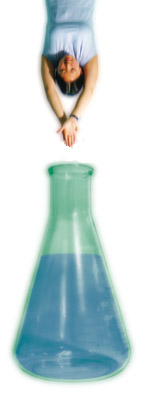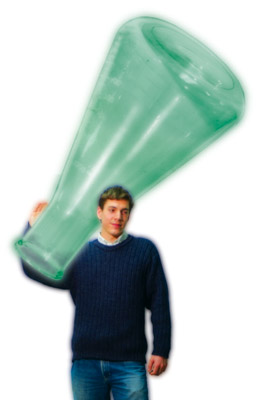 |
|
|||||||||
| Immersion theory How one Chicago professor teaches biology—and why it’s a harbinger for science education to come.
“This is all about baby steps,” she says, stretching out the “all” as if to temper the expectations of a visitor hoping to witness some sparks-flying Science-with-a-capital-S. If Stephen J. Kron, associate professor in Molecular Genetics & Cell Biology, the Committees on Cancer Biology and Genetics, and the Center for Molecular Oncology, could hear her, he would flash one of his “see what I mean?” grins. Kron’s lab is where the container’s contents—if Testa can achieve the reaction and build a special type of peptide—will end up, as a substrate to grow mutated strains of yeast. Kron has known Testa since she was a first-year in his winter quarter AP 5 molecular biology class (as the name implies, a course for students who scored a 5 on the Advanced Placement biology exam). The following year she and her cohorts returned to Kron’s AP 5 class as second-year teaching fellows, and many have since joined his lab. When she graduates she’ll do what most of those students intend to do: go on to graduate school in science—in her case, chemistry—and head for a research career. If Kron’s hunch is right, Testa and her peers will be among the more creative, persistent graduate students that their doctoral advisers encounter. It’s all part of a new way to teach science, one that plunges students into current research, that trains them to think and act like scientists from the beginning of their college experience, that gives them the tools not to be intimidated by complicated experiments or frustrated by baby steps. Although the course enrolls only 12 to 20 students annually out of about 115 biological-sciences concentrators and 113 physical-sciences concentrators in each class year, at least one major group of research scientists believes an approach like Kron’s is essential to educating the next generation—perhaps even recruiting a few students who never believed a research career was within their reach. The new way to teach science can be found in an unassuming tome that costs $23.96, or it can be read online for free (www.nap.edu/books/0309085357/html). José Quintáns, associate dean and master of the Biological Sciences Collegiate Division (BSCD) and professor in pathology and the College, tends to take a copy with him to meetings with administrators from the College and Biological and Physical Sciences Divisions, and to say things like, “Read the book! The book explains everything!” The book is Bio 2010: Transforming Undergraduate Education for Future Research Biologists, published this year by the National Research Council (NRC) of the National Academies. Quintáns’s goal is to teach all biology majors “a la Bio 2010—that is, inquiry-based, interdisciplinary learning.” The report’s premise is that biological research has left traditional undergraduate curricula in its dust—not a good thing, because college is where future researchers develop their passion. The mapping of the human genome, the digital revolution, and the blurring of boundaries between the biological, physical, and mathematical sciences have researchers doing their work in entirely new ways—witness Chicago’s forthcoming Interdisciplinary Research Building (IRB), which will house the interdisciplinary Institute for Biophysical Dynamics (IBD). Yet more often than not, the NRC says, undergraduates learn biology as a series of facts set in cement rather than unanswered questions, as experiments to be replicated in labs rather than analyzed critically, built upon, or tossed aside. The authors—11 biologists chaired by Stanford’s Lubert Stryer and including researchers from major public and private universities, a small college, and a private research institute—call on undergraduate institutions to rethink their courses and curricula with an eye toward real-life problems and the excitement of open-ended inquiry. Undergraduates need mentors, the report says. They need to work in groups, and they need to be exposed to the stumbling, fumbling work of research labs. And they need all of this as early as possible—in their freshman year rather than their junior or senior year, when their inquisitiveness has calcified from doing one too many problem sets that inevitably conclude a textbook chapter. Bio 2010 gives examples of classes and undergraduate curricula that move beyond the cemented-facts model. Chicago’s AP 5 course isn’t mentioned, but it could be. Four years ago Kron began teaching the course, officially titled Molecular Biology II, with a five-year grant from the National Science Foundation. The reasoning behind the course was that, as Quintáns puts it, “giving AP credit is the worst thing a college can do. By letting those students place out of general-education requirements in biology, we lost them entirely.” Certainly many of those students end up majoring in other sciences, but some avoid the sciences altogether, perhaps because they find college-level science courses intimidating or they prefer the analytical thinking, judgment, and discussion skills emphasized in the social sciences or humanities. In Quintáns’s view those undergrads who, despite their aptitude, don’t consider themselves science types could very well turn out to be highly creative researchers. All College students must complete general-education requirements in the biological and physical sciences. Nonconcentrators can take either a two-quarter sequence in each division or a five-quarter sequence that integrates both. Concentrators must take a five-quarter fundamental sequence. Kron’s two-quarter AP 5 Fundamental Sequence replaces either five-quarter general-education sequence. During winter quarter of their first year the AP 5 students enroll in Molecular Biology I, a traditional lecture course in which they learn about DNA, RNA, and proteins; basic methods in molecular biology; DNA replication, recombination, and transposition; transcription in cell types; translation; regulation of gene expression; and other essential topics. Come spring quarter, they walk into Kron’s classroom, and he promptly tosses them “into the deep end.” The class has no syllabus and no text. It meets three days a week, each week focusing on a different scientific paper recently published by Chicago biology researchers, following a journal club format often used in research laboratories. In recent years, for example, Kron’s students have read “Analysis of a mutant exhibiting conditional sorting to dense core secretory granules in Tetrahymena thermophila” by doctoral student Grant R. Bowman and his thesis adviser, Aaron P. Turkewitz. And there was “Herpes simplex virus 1-infected cell protein 0 contains two E3 ubiquitin ligase sites specific for different E2 ubiquitin conjugating enzymes” by then-doctoral student Ryan Hagglund, SM’01, PhD’03, and his adviser, Bernard Roizman. Each week follows the same pattern. On Mondays two of Kron’s teaching assistants—drawn from the previous year’s AP 5 students and dubbed Lerman-Neubauer Junior Teaching Fellows—give a one-hour presentation introducing the paper’s topic. On Wednesdays one of the paper’s authors visits the class for a question-and-answer session. Fridays offer the students their turn to present. Together they dissect the paper’s experiments, analyze and critique the logic, and expose weaknesses and strengths. As is de rigueur at actual journal clubs, the students bring food, usually bagels or doughnuts and orange juice, which Kron underwrites. For Saturday’s session each student must write an essay the length of a journal abstract—“because that’s how science moves these days,” explains Kron. From the beginning to the end of the course he grades the first-years as if they were graduate students. “Not surprisingly, the kids simply fail the first five or six weeks,” he says. The opening day of class is a pep talk, starting with his favorite line: “You are already disappointing me.” He warns them, “Every one of you starts with an F. There is no way for you to pass—forget about a decent grade—unless you listen to feedback, work hard, and work together.” (Back in his office, he says, the second-years complain, “You were too easy on them! You were so much harder on us!”) Kron is true to his word—he and his teaching assistants hand out Ds and Fs with pointed criticisms week after week. The students call home, they get angry at each other, they get angry at him. “They spend way too much time on the class,” Kron says. But the result is that they become fiercely loyal—to him and to each other—“which is what being in a lab is all about.” At quarter’s end the class divides into small groups; each picks a recently published paper, finds the authors on campus, grills them on their research, and then gives a final PowerPoint presentation on the work’s merits and kinks. Revised essays are submitted. Kron grades each student on his or her individual progress, and he has never had to give a final grade lower than a B. “You have to let them fail, but you always have to save them,” he says, echoing the role of a real-world lab chief. The result is that many students, though certainly not all, become addicted to science. They get a taste of life in the lab, and they want more. In the last weeks before summer break, often with help from Kron or graduate students they have met, many of the students line up full-time research jobs. If they join his lab, Kron sets them loose and they learn by “screwing up,” he says, often making “spectacular discoveries” along the way. “Undergraduates can make observations that are unexpectedly good because they are too naive to know not to look.”
It’s been almost two years since Testa enrolled in Kron’s class, and she’s since taken lots of classic science courses: organic chemistry, inorganic chemistry, physical chemistry, some biology and physics. Kron’s class, she says, was a great experience because “it gave me an idea of what I’m getting into with a career in research.” Does she wish her other courses were more like it? “I’m not foolish enough to think I don’t need book science,” she replies. Anyway, she adds, “once you get past the introductory courses,” professors begin to “treat you like graduate students.” Quintáns and Kron aren’t so sure that “book science” and the AP 5 model have to be mutually exclusive. The Bio 2010 authors clearly don’t think so. Successful future researchers, they write, need “not just expertise in the specific biological system under study, but a conceptual understanding of the science of life and where a specific research topic fits into the overall picture.” Nor does the NRC believe that the coursework of disciplines must remain distinct in the way that Testa has experienced it. “Much of today’s biomedical research is at the interface between biology and the physical, mathematical, or information sciences,” they note. “However, faculty often do not integrate these subjects into the biology courses they teach,” producing shortsighted students who “do not see the relevance of their other science courses to their chosen field of study.” The NRC’s New Biology Curriculum integrates chemistry, physics, engineering, math, and computer science early and often. The College, Quintáns believes, could learn a lot from Bio 2010. Last spring the BSCD doubled its capacity of Bio 2010–type courses with Viruses as Probes of Cellular Function, a lab-based course for 12 AP 5 first-years taught by pioneering virologist Bernard Roizman, the Joseph Regenstein distinguished service professor in the Department of Molecular Genetics & Cell Biology. This year the BSCD introduces a third course, Developmental Neuroscience, taught by Melina Hale, PhD’98, assistant professor of organismal biology & anatomy, and a companion series on biomathematics designed to be integrated with all of the AP 5 courses. For his part, Kron dreams of a “molecular sciences” concentration that would be modeled after the Committee on Social Thought, erasing disciplinary lines, encouraging debate and free thinking, with the sink-or-swim spirit of his AP 5 course. Meanwhile, Quintáns has approached the Physical Sciences Collegiate Division about beginning to more fully integrate undergraduate teaching in the same way that the divisions are combining their work at the graduate and postdoctoral level with the forthcoming IRB and IBD. He realizes, of course, that it’s all about baby steps.
|
|
Contact
|

 Emily
Testa, ’05, has been keeping watch
Emily
Testa, ’05, has been keeping watch  Kron’s
own lab works on cell proliferation
Kron’s
own lab works on cell proliferation